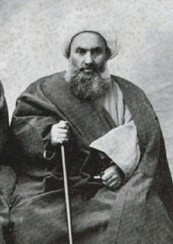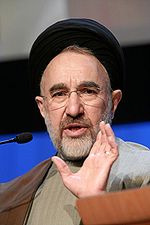
Clericalism in Iran
Encyclopedia

Emergence
There are controversies about the emergence of clericalism in Iran. Some scholars believe that clericalism dates back to 1000 years ago.Schools

- NajafNajafNajaf is a city in Iraq about 160 km south of Baghdad. Its estimated population in 2008 is 560,000 people. It is the capital of Najaf Governorate...
seminaries - QomQomQom is a city in Iran. It lies by road southwest of Tehran and is the capital of Qom Province. At the 2006 census, its population was 957,496, in 241,827 families. It is situated on the banks of the Qom River....
seminaries - Mashad Seminaries
Sunni:
- ZahedanZahedanZahedan is a city in and the capital of Sistan and Baluchestan Province, Iran. At the 2006 census, its population was 552,706, in 109,488 families.-Geography:...
seminaries
Structure and functions:
Over the course of history, Iranian seminaries have had traditional functions in the religious sphere to provide support to civil society in the country. However after the Iranian revolution in 1979, seminaries have been highly politicized and their independence greatly reduced. The revolution created a new political order based on Shiite theological foundations and the absolute ruling power was given to a Shiite jurist/cleric.
The history of Qom seminaries dates back to 3rd century (Hijri). Hossein Ibn Said Ahvazi, a famous theologian, moved from Kufa to Qom. He educated the first generation of clerics in Qom.
Impact on economy
Many clerics have been involved in high profile economic activities, most notably Akbar Hashemi Rafsanjani, Abbas Vaez-TabasiAbbas Vaez-Tabasi
Ayatollah Abbas Vaez Tabasi is an influential member of the Expediency Discernment Council and the Assembly of Experts of the Islamic Republic of Iran.Furthermore, Vaez-Tabasi is the head of the Astan Quds Razavi Foundation...
and Nasser Makarem Shirazi.
Impact on Iranian politics
Clerics involved in politics during Safavid and Qajar era- Allameh Majlesi
- Mirza Shirazi
- Seyyed Jamaluddin Asadabadi (Afghani)
Clerics involved in Iranian Constitutional Revolution
Iranian Constitutional Revolution
The Persian Constitutional Revolution or Iranian Constitutional Revolution took place between 1905 and 1907...
- Seyyed Mohammad Tabataba'i
- Seyyed Abdollah Behbehani
- Sheikh Mohammad Khiabani
- Mohammad Kazem KhorasaniMohammad Kazem KhorasaniMohammad Kazem Khorasani was a Twelver Shi'a Marja, Persian politician, philosopher, reformer, born in Tous in northwestern Iran...
- Sheikh Fazlollah Nouri (against the Constitutional Revolution)
- Mohammed Kazem YazdiMohammed Kazem YazdiMohammed Kazem Yazdi was a prominent Shia Islamic scholar centered in Najaf, most famous for his anti-constitutionalist stand during the Iranian Constitutional Revolution of 1905-1911...
(against the Constitutional Revolution)
Influential Clerics of Pahlavi
Pahlavi dynasty
The Pahlavi dynasty consisted of two Iranian/Persian monarchs, father and son Reza Shah Pahlavi and Mohammad Reza Shah Pahlavi The Pahlavi dynasty consisted of two Iranian/Persian monarchs, father and son Reza Shah Pahlavi (reg. 1925–1941) and Mohammad Reza Shah Pahlavi The Pahlavi dynasty ...
era
- Seyyed Hassan ModarresHassan ModarresSeyyed Hassan Modarres , was an Iranian Twelver Shi'a cleric and a notable supporter of the Iranian Constitutional Revolution. He was among the founding members, along with Abdolhossein Teymourtash, of the reformist party Hezb-e Eslaah-talab of the time, which was formed during the fourth...
- Seyyed Abolghasem Kashani
- Navvab SafaviNavvab SafaviNavvab Safavi was a cleric responsible for founding of the Fadayan-e Islam group and with them the assassination of several leading Iranians, primarily politicians.-Early life:...
- Sheikh Mohammad Taghi Falsafi
Clerics involved in Iranian revolution
Iranian Revolution
The Iranian Revolution refers to events involving the overthrow of Iran's monarchy under Shah Mohammad Reza Pahlavi and its replacement with an Islamic republic under Ayatollah Ruhollah Khomeini, the leader of the...
- Ruhollah KhomeiniRuhollah KhomeiniGrand Ayatollah Sayyed Ruhollah Musavi Khomeini was an Iranian religious leader and politician, and leader of the 1979 Iranian Revolution which saw the overthrow of Mohammad Reza Pahlavi, the Shah of Iran...
- Hosseinali Montazeri
- Morteza MotahhariMorteza MotahhariAyatollah Murtaza Motahhari was an Iranian scholar, cleric, lecturer, and politician.Motahhari is considered among the important influences on the ideologies of the Islamic Republic, and was a co-founder of Hosseiniye Ershad and the Combatant Clergy Association...
- Mohammad Beheshti
Clerics acted as high officials

- Ali KhameneiAli KhameneiAyatollah Seyed Ali Hoseyni Khāmene’i is the Supreme Leader of Iran and the figurative head of the Muslim conservative establishment in Iran and Twelver Shi'a marja...
- Akbar Hashemi RafsanjaniAkbar Hashemi RafsanjaniAyatollah Akbar Hashemi Rafsanjani is an influential Iranian politician and writer, who was the fourth President of Iran. He was a member of the Assembly of Experts until his resignation in 2011...
- Mohammad KhatamiMohammad KhatamiSayyid Mohammad Khātamī is an Iranian scholar, philosopher, Shiite theologian and Reformist politician. He served as the fifth President of Iran from August 2, 1997 to August 3, 2005. He also served as Iran's Minister of Culture in both the 1980s and 1990s...
- Mohammad YazdiMohammad YazdiAyatollah Mohammad Yazdii is an Iranian cleric who served as the head of Judiciary System of Iran between 1989 and 1999, following Ayatollah Abdolkarim Mousavi Ardebili and succeeded by Ayatollah Mahmoud Hashemi Shahroudi....
- Ali MeshkiniAli MeshkiniAyatollah Ali Akbar Feyz Meshkini was an Iranian hardline cleric and politician.-Life:Meshkini was an Iranian Azerbaijani born in a village near Meshkinshahr and the Sabalan mountain. He was born as Āli, but preferred the pronounciaton, Ali during his career. He succeeded Ayatollah Montazeri as...
- Mahmoud Hashemi ShahroudiMahmoud Hashemi ShahroudiGrand Ayatollah Seyyed Mahmoud Hashemi Shahroudi is a moderate Iraqi-Iranian politician and Twelver Shi'a Marja. Hashemi Shahroudi was the leader of the Supreme Council for the Islamic Revolution in Iraq, which has caused objections to his serving as the head of Iran's Judiciary System upon his...
- Ahmad JannatiAhmad JannatiAyatollah Ahmad Jannati Massah is a hardline Iranian politician, fundamentalist Shi'i cleric and a founding member of Haghani school with close ties with Mahmoud Ahmadinejad and Mesbah-Yazdi...
- Mehdi KarroubiMehdi KarroubiMehdi Karroubi is an influential Iranian reformist politician, democracy activist, mojtahed, and chairman of the National Trust Party. He was Chairman of the parliament from 1989 to 1992 and 2000 to 2004, and a presidential candidate in the 2005 and 2009 presidential elections.He is a founding...
Political parties founded by clerics
- Association of Combatant Clerics
- Combatant Clergy Association
Institutions exclusively associated with clerics
- Special court for clerics
See also
- Islam in IranIslam in IranThe Islamic conquest of Persia led to the end of the Sassanid Empire and the eventual decline of the Zoroastrian religion in Persia. However, the achievements of the previous Persian civilizations were not lost, but were to a great extent absorbed by the new Islamic polity...
- History of Qom seminaries (in Persian)
- Organization of Shafei Sunni Clericalism in Iran (in Persian)
- Organization of Hanafi Sunni Clericalism in Iran (in Persian)

